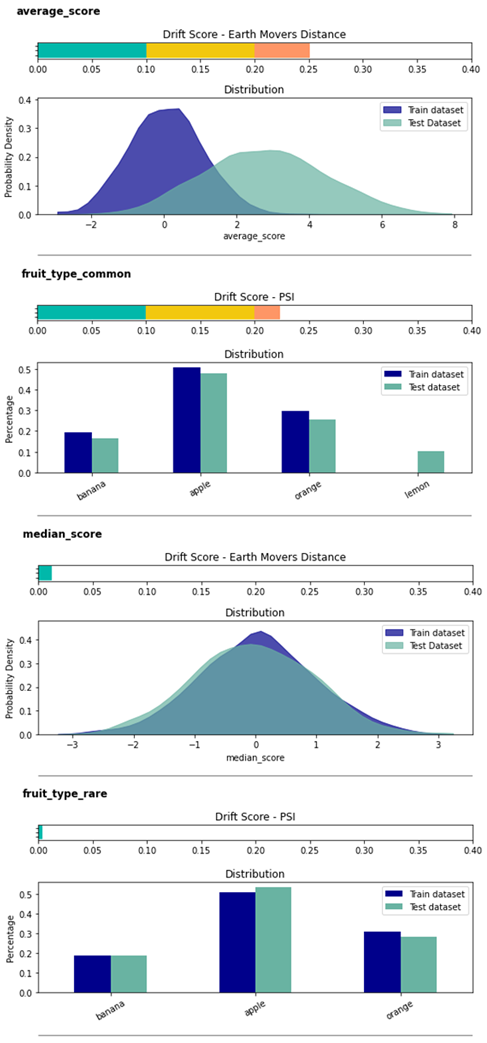Join Slack | Documentation | Blog | Twitter
Deepchecks is a Python package for comprehensively validating your machine learning models and data with minimal effort. This includes checks related to various types of issues, such as model performance, data integrity, distribution mismatches, and more.
pip install deepchecks -U --userconda install -c deepchecks deepchecksA Suite runs a collection of Checks with optional Conditions added to them.
For a full suite demonstration, check out the Quickstart Notebook and apply it on your own data and models. You can launch it directly on google colab or on binder from within the documentation.
Let's take the "iris" dataset as an example
from sklearn.datasets import load_iris
iris_df = load_iris(return_X_y=False, as_frame=True)['frame']To run an existing suite all you need to do is to import the suite and to run it with the required (suite-dependent) input parameters
from deepchecks.suites import single_dataset_integrity
suite = single_dataset_integrity()
suite.run(iris_df)Which will result in printing the suite outputs, starting with a summary of the check conditions
The suite is composed of various checks such as: Mixed Data Types, Is Single Value, String Mismatch, etc...
Each check may contain conditions (which will result in pass / fail / warning, represented by ✓ / ✖ / ! ), as well as other outputs such as plots or tables.
Suites, checks and conditions can all be modified (see the Create a Custom Suite tutorial).
Status Check Condition More Info Single Value in Column - Test Dataset Does not contain only a single value for all columns Columns containing a single value: ['target'] Data Duplicates - Test Dataset Duplicate data is not greater than 0% Found 2.00% duplicate data Mixed Nulls - Test Dataset Not more than 1 different null types for all columns Mixed Data Types - Test Dataset Rare data types in all columns are either more than 10.00% or less than 1.00% of the data String Mismatch - Test Dataset No string variants for all columns String Length Out Of Bounds - Test Dataset Ratio of outliers not greater than 0% string length outliers for all columns Special Characters - Test Dataset Ratio of entirely special character samples not greater than 0.10% for all columns
Followed by the visual outputs of all of the checks that are in that suite, that isn't appended here for brevity.
To run a specific single check, all you need to do is import it and then to run it with the required (check-dependent) input parameters. More details about the existing checks and the parameters they can receive can be found in our API Reference.
from deepchecks.checks import TrainTestFeatureDrift
import pandas as pd
train_df = pd.read_csv('train_data.csv')
train_df = pd.read_csv('test_data.csv')
# Initialize and run desired check
TrainTestFeatureDrift().run(train_data, test_data)Which will produce output of the type:
The Drift score is a measure for the difference between two distributions, in this check - the test and train distributions.
The check shows the drift score and distributions for the features, sorted by feature importance and showing only the top 5 features, according to feature importance. If available, the plot titles also show the feature importance (FI) rank.
Each check enables you to inspect a specific aspect of your data and models. They are the basic building block of the deepchecks package, covering all kinds of common issues, such as:
- Model Error Analysis
- Label Ambiguity
- Data Sample Leakage
and many more checks.
Each check can have two types of results:
- A visual result meant for display (e.g. a figure or a table).
- A return value that can be used for validating the expected check results (validations are typically done by adding a "condition" to the check, as explained below).
A condition is a function that can be added to a Check, which returns a pass ✓, fail ✖ or warning ! result, intended for validating the Check's return value. An example for adding a condition would be:
from deepchecks.checks import BoostingOverfit
BoostingOverfit().add_condition_test_score_percent_decline_not_greater_than(threshold=0.05)which will return a check failure when running it if there is a difference of more than 5% between the best score achieved on the test set during the boosting iterations and the score achieved in the last iteration (the model's "original" score on the test set).
An ordered collection of checks, that can have conditions added to them. The Suite enables displaying a concluding report for all of the Checks that ran. See the list of predefined existing suites to learn more about the suites you can work with directly and also to see a code example demonstrating how to build your own custom suite. The existing suites include default conditions added for most of the checks. You can edit the preconfigured suites or build a suite of your own with a collection of checks and optional conditions.
Depending on your phase and what you wish to validate, you'll need a subset of the following:
- Raw data (before pre-processing such as OHE, string processing, etc.), with optional labels
- The model's training data with labels
- Test data (which the model isn't exposed to) with labels
- A model compatible with scikit-learn API that you wish to validate (e.g. RandomForest, XGBoost)
Deepchecks validation accompanies you from the initial phase when you have only raw data, through the data splits, and to the final stage of having a trained model that you wish to evaluate. Accordingly, each phase requires different assets for the validation. See more about typical usage scenarios and the built-in suites in the docs.
- https://docs.deepchecks.com/ - HTML documentation (stable release)
- https://docs.deepchecks.com/en/latest - HTML documentation (latest release)
- Join our Slack Community to connect with the maintainers and follow users and interesting discussions
- Post a Github Issue to suggest improvements, open an issue, or share feedback.




